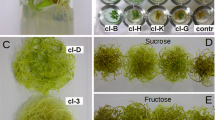Abstract
Hairy root cultures of Lithospermum canescens were established using three strains of Agrobacterium rhizogenes: ATCC 15834, LBA 9402 and NCIB 8196. Eight lines resulting from infection with A. rhizogenes ATCC 15834 demonstrated sufficient biomass increase and were submitted to further investigations. The contents of acetylshikonin (ACS) and isobutyrylshikonin (IBS) in transformed hairy roots made up ca. 10% of those observed in natural roots of L. canescens (24.35 and 14.48 mg g−1 DW, respectively). One line, Lc1-D, produced the largest amounts of ACS (2.72 mg g−1 DW) and IBS (0.307 mg g−1 DW). Traces of pyrrolizidine alkaloids (PA), canescine and canescenine, were found in all lines of transformed hairy roots.



Similar content being viewed by others
Abbreviations
- ACS:
-
acetylshikonin
- DW:
-
dry weight
- IBS:
-
isobutyrylshikonin
- PA:
-
pyrrolizidine alkaloids
References
Birgham LA, Michaels PJ, Flores HE (1999) Cell-specific production and antimicrobial activity of naphthoquinones in roots of Lithospermum erythrorhizon. Plant Physiol 119:417–428
Boom R, Sol C, Beld M, Weel J, Goudsmit J, Wertheim-van Dillen P (1999) Improved silica-guanidiniumthiocyanate DNA isolation procedure based on selective binding of bovine alpha-casein to silica particles. J Clin Microbiol 37:615–619.
Chang HN, Sim SJ (1996) Genetic transformation of Lithospermum erythrorhizon for increased production of shikonin. In: Bajaj YPS (ed) Biotechnology in agriculture and forestry, vol 38. Plant protoplasts and genetic engineering VII. Springer-Verlag, Berlin Heldelberg, pp 233–242
Fujita Y, Hara Y, Suga C, Morimoto T (1981) Production of shikonin derivatives by cell suspension cultures of Lithospermum erythrorhizon. A new medium for the production of shikonin derivatives. Plant Cell Rep 1:61–63
Hiroshi K, Hitoshi S (1988) Production of naphthoquinone compound. JP–J63230093
Hosokawa K, Matsuki R, Oikawa Y, Yamamura S (1997) Genetic transformation of gentian using wild-type Agrobacterium rhizogenes. Plant Cell Tissue Organ Cult 51:137–140
Kropczyńska D, Kawka B, Pietrosiuk A, Furmanowa M, Wiedenfeld H (2004) The effect of pyrrolizidine alkaloids on the Colorado potato beetle (Leptinotarsa decemlineata Say). Acta Biol Cracoviensia Ser Zool 46:83–86
Linsmaier EM, Skoog F (1965) Organic growth factor requirement in relationship to cytokinin in “normal” and “mutant” strains of tobacco callus. Planta 72:146–154
Mattocks AR (1967) Detection of pyrrolizidine alkaloids on thin-layer chromatograms. J Chromatogr 27:505–508
Papageorgiou VP, Assimopoulou AN, Couladouros EA, Hepworth D, Nicolaou KC, (1999) The chemistry and biology of alkannin, shikonin, and related naphtazarin natural products. Angew Chem Int Ed 38:270–300
Payne GF, Bringi V, Prince C, Shuler ML (1991) Quantifying growth and product synthesis: kinetics and stoichiometry. In: Payne GF, Bringi V, Prince C, Shuler ML (eds) Plant cell and tissue culture in liquid systems. Hanser Publishers, Munich Vienna New York Barcelona, pp 48–70
Pietrosiuk A, Furmanowa M, Kropczyńska D, Kawka B, Wiedenfeld H (2003a) Life history of the two-spotted spider mite (Tetranychus urticae Koch) feeding on bean leaves treated with pyrrolizidine alkaloids. J Appl Toxicol 23:187–190
Pietrosiuk A, Kędzia B, Hołderna-Kędzia E, Wiedenfeld H, Malinowski M, Furmanowa M (2003b) Antimicrobial activity of naphthoquinones from Lithospermum canescens Lehm. Herba Polonica 49(3/4):209–215
Pietrosiuk A, Skopińska-Różewska E, Furmanowa M, Wiedenfeld H, Sommer E, Sokolnicka I, Bany J, Malinowski M (2004a) Immunomodulatory effect of shikonin derivatives isolated from Lithospermum canescens on cellular and humoral immunity in Balb/c mice. Die Pharmazie 59:640–642
Pietrosiuk A, Furmanowa M, Skopińska-Różewska E, Sommer E, Skurzak H, Bany J (2004b) The effect of acetylshikonin isolated from Lithospermum canescens roots on tumor-induced cutaneous angiogenesis. Acta Polon Pharm Drug Res 61(5):379–382
Pietrosiuk A, Wiedenfeld H (2005) Shikonin derivatives from Lithospermum canescens (Michx.) Lehm. Pharm Biol 43(2):189–191
Schenk RU, Hildebrandt AC (1972) Medium and techniques for induction and growth of monocotyledonous and dicotyledonous plant cell cultures. Can J Bot 50:199–204
Shimomura K, Sudo H, Saga H, Kamada H (1991) Shikonin production and secretion by hairy root cultures Lithospermum erythrorhizon. Plant Cell Rep 10:282–285
Sykłowska-Baranek K, Pietrosiuk A, Dłuska H, Furmanowa M (2004) Clonal multiplication of Lithospermum canescens (Michx.) Lehm. and Onosma paniculatum (Bur. and Franch). Herba Polonica 51(2):38–47
Tabata M (1985) Production of shikonin by plant cell cultures. In: Zaitlin M, Day P, Hollaender A (eds) Biotechnology in plant science. Relevance to agriculture in the eighties. Academic Press, Inc., pp 207–218
USDA, NRCS (2004) The PLANTS Database, Version 3.5 (http://plants.usda.gov). National Plant Data Center, Baton Rouge, LA 70874-4490 USA
Vervliet G, Holsters M, Teuchy H, Van MM, Schell J (1975) Characterization of different plaque-forming and defective temperate phages in Agrobacterium. J Gen Virol 26:33–48
Wiedenfeld H., Pietrosiuk A., Furmanowa M., Roeder E. (1998) Pigments compounds in Lithospermum canescens Lehm. In 46th annual congress society for medicinal plant research—“quality of medicinal plants and herbal medicinal products,” August 31st–September 4th, 1998, Vienna, Austria
Wiedenfeld H, Pietrosiuk A, Furmanowa M, Roeder E (2003) Pyrrolizidine alkaloids from Lithospermum canescens Lehm. Z Naturforsch 58c:173–176
Yazaki K. Tanaka S, Matsuoka H, Sato F (1998) Stable transformation of Lithospermum erythrorhizon by Agrobacteriun rhizogenes and shikonin production by transformants. Plant Cell Rep 18:214–219
Yoshikawa N, Fukui H, Tabata M (1986) Effect of gibberellin A3 on shikonin production in Lithospermum callus cultures. Phytochemistry 25(3):621–622
Acknowledgements
This investigation was supported by a research grant PBZ-KBN-092/P05/2003 from the State Committee of Scientific Research. We are thankful to Dr. Branka Barl, chief scientist, New Era Nutrition, Inc., Edmonton, Alberta, for plants and seeds of L. canescens. We are also grateful to Professor Mondher Jaziri from the Laboratory of Biotechnology and Plant Morphology, Free University of Brussels for the bacterial strain A. rhizogenes NCIB 8196. We thank Mr Ireneusz Rudnicki, Photodepartment of Medical University of Warsaw, Poland for photographic documentation.
Author information
Authors and Affiliations
Corresponding author
Additional information
Communicated by M. E. Horn
Rights and permissions
About this article
Cite this article
Pietrosiuk, A., Sykłowska-Baranek, K., Wiedenfeld, H. et al. The shikonin derivatives and pyrrolizidine alkaloids in hairy root cultures of Lithospermum canescens (Michx.) Lehm.. Plant Cell Rep 25, 1052–1058 (2006). https://doi.org/10.1007/s00299-006-0161-2
Received:
Accepted:
Published:
Issue Date:
DOI: https://doi.org/10.1007/s00299-006-0161-2




